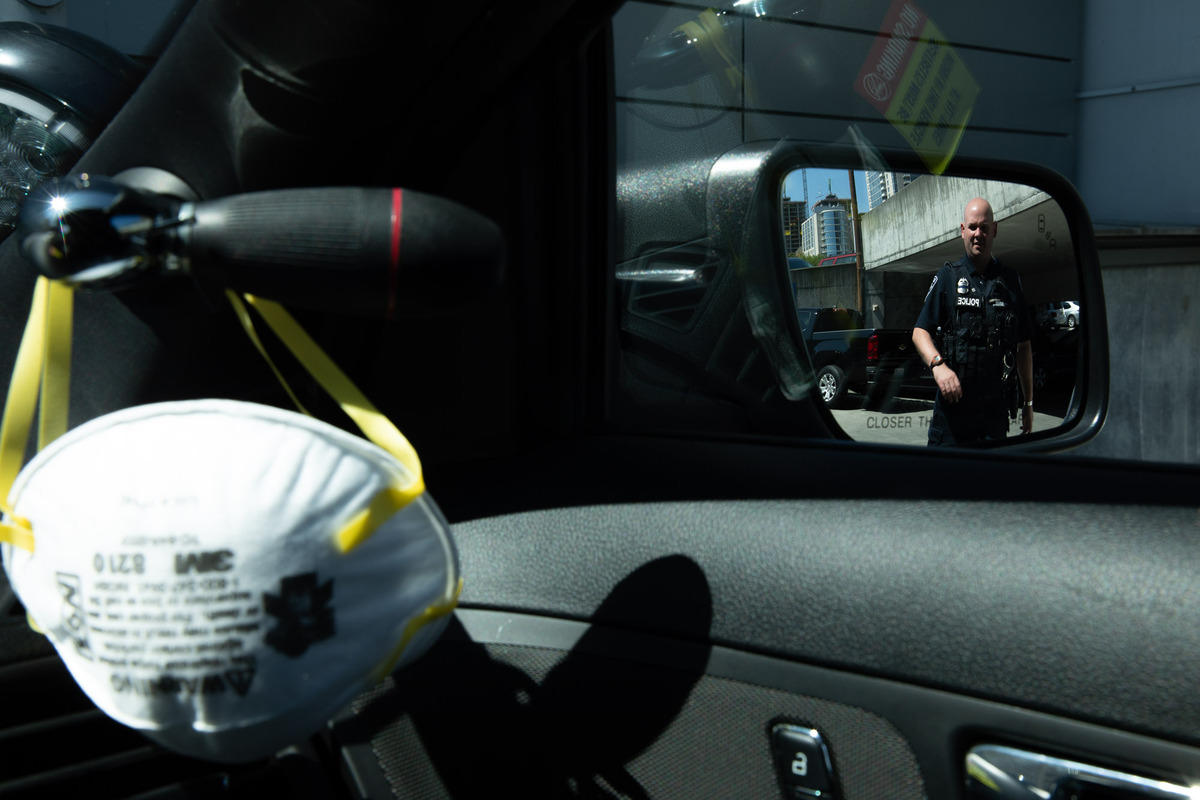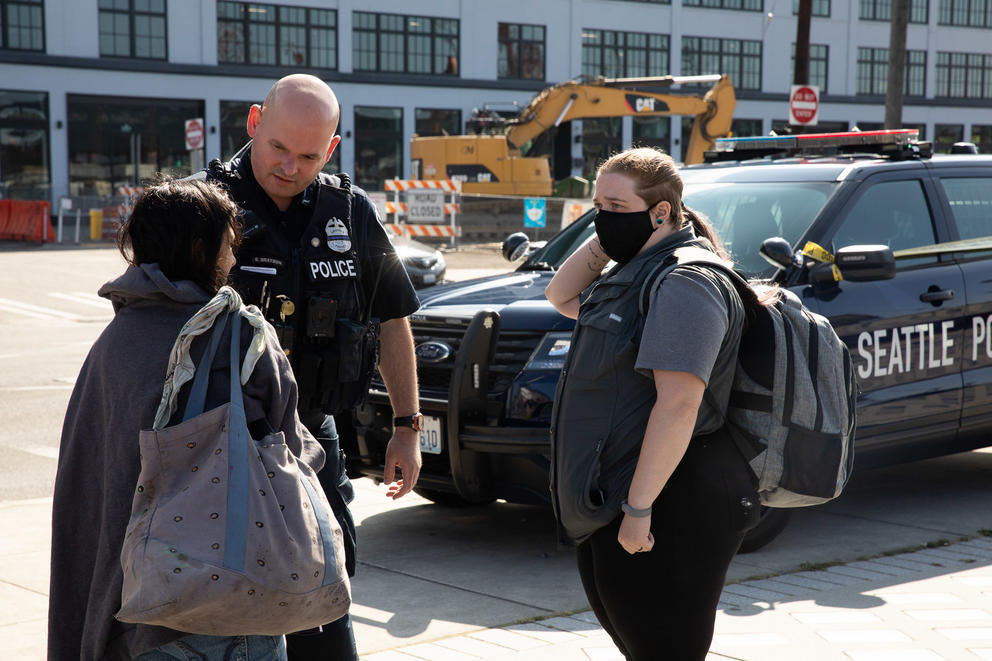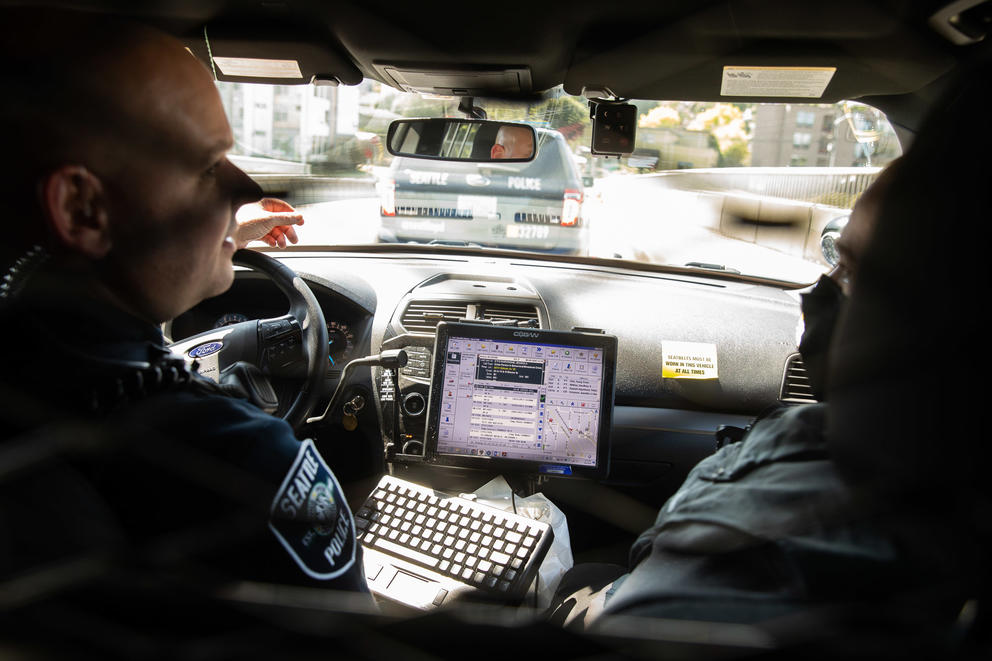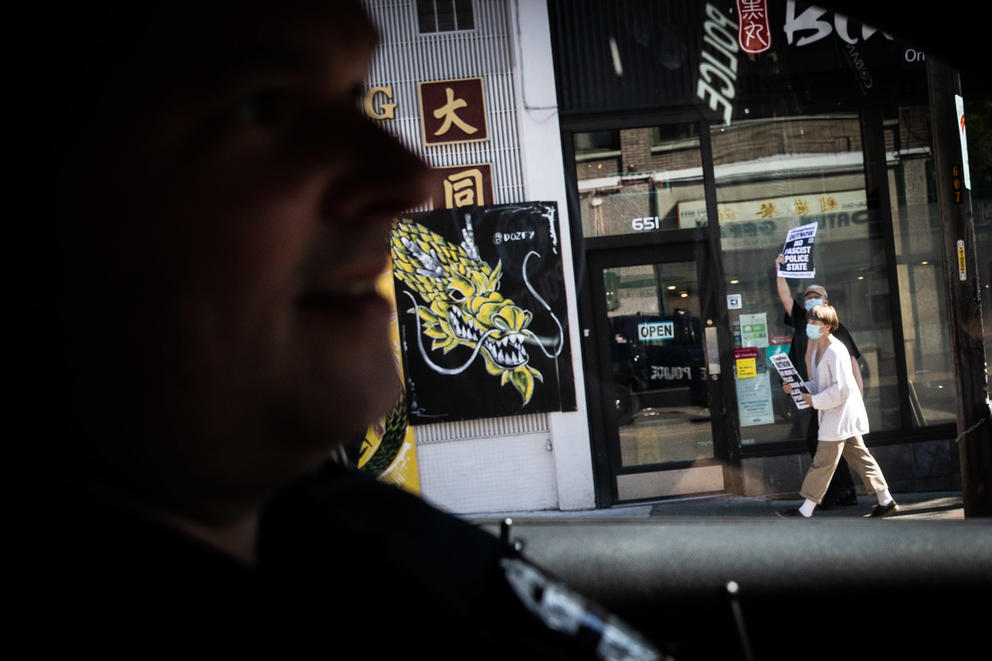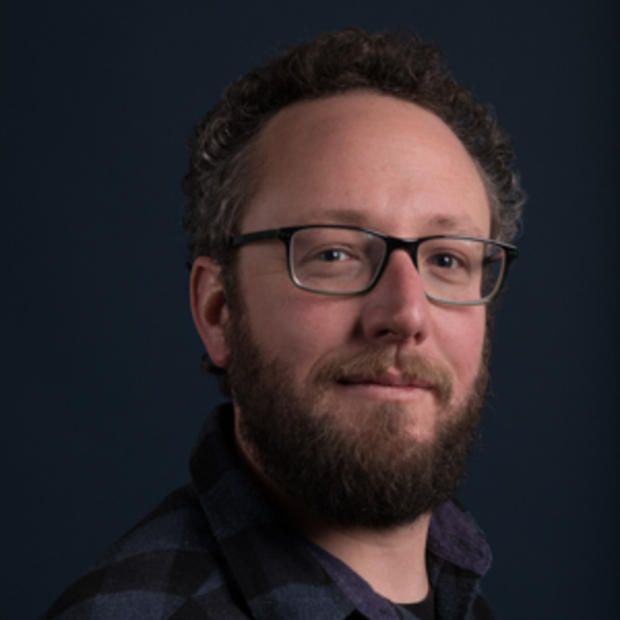Emily Katz crossed the street from the Downtown Emergency Service Center off Third Avenue, where, as nurse manager, she and a sparse team shoulder the unending task of caring for a homeless population few others bother to care for.
Police Officer Sandlin Grayson saw the wounded man from his patrol car. No Seattle police officer in at least the past five years has taken more calls for people in crisis — those struggling with mental illness, thoughts of suicide or substance use — than Grayson, according to department data.
This was the second time on that late-July Thursday the nurse and officer had met; a man had overdosed in the alley behind the shelter across the street hours earlier. And each time they cross paths like this — when there was no obvious crime, just a person struggling deeply — a question lingered in the air: Who needs to be here, really?
The same question has hung low over City Hall in recent months, as protests have forced a reexamination of what it is police are tasked to do. "Defund the police" is the rallying cry and one that's become a political cleaver in Seattle and the nation. But beneath the blunt phrase is a nuance that even those in law enforcement tend to agree is worth examining: What is it that police are doing that should be passed along to someone else?
Nowhere does that question land hardest than on how and why cops show up for people in mental health or substance use crises. In 2019, Seattle police logged over 16,000 crisis calls, according to department data. What proportion of those dispatches needed an armed officer to respond is difficult to say. But what’s clear is that, many times, these cases are laid at the feet of law enforcement only because the public is unsure where else to turn. In a system that lacks better alternatives — and the foresight to see that systemic problems do not vanish on their own — emergency first responders become the default solution, which means cops are the default solution.
Seattle Police Department's Crisis Response Team officer Sandlin Grayson, at right, visits the houseless encampment at Western Ave and Marion Street, where the victim of a fatal stabbing in front of Seattle Fire Department's Station 5 lived, helping homicide detectives, at left, and notifying his neighbors of what has happened, on August 6, 2020 in Seattle. (Matt M. McKnight/Crosscut)
Few are happy about it.
"If you were to pull 100 cops into an office and you say, 'Hey, gang, we're going to come up with a system so you don't have to respond to mental health-related calls,' you would enjoy 100% support," said Lt. Dan Nelson, commander of the Seattle Police Department's Crisis Response Team.
But creating alternatives to police response, particularly for people in crisis, means battling a decadeslong gravitational pull toward the bottom of the safety net. Scratch at any interaction between police and a person in crisis, and the systems that did not and likely will not prevent that meeting from happening reveal themselves.
"We've just defaulted to this way of doing things as a community and as a society for a long time," said Daniel Malone, executive director of the Downtown Emergency Service Center.
The balance, then, is finding the best thing in that moment of contact — for the people in crisis, for the police, for workers like Katz — while not losing track of why that moment happened at all.
When he approached the man with no shirt, Grayson concluded the man was a risk to himself. The man had stepped briefly into the road and was insisting his swollen eye was a mask. But as Grayson left his car to engage, the man walked in the opposite direction, toward the other end of the block.
Katz, meanwhile, had crossed the street from DESC to treat the man's wounds, independently of the police response. She met him as he walked away from Grayson, and the man repeated to her that he was wearing a mask, Katz recalled. She asked if he liked the mask. When he said no, she offered to help him take it off. He calmed down and said OK.
But because Grayson had seen the man step off the sidewalk earlier, the police officer was worried the man could be hit by a bus. And when a person is considered a danger to themselves or others, officers have the authority — and duty, in their view — to commit that person to the hospital. So Grayson whipped his car around to where Katz was treating the man, got out and put him in handcuffs.
As police restrained him on a stretcher, the man, who'd calmed considerably while speaking with Katz, screamed. Grayson and the other officers who arrived paid little mind as Katz packed her things and walked away, angry.
"It was in everyone's best interest to sit him down and control him physically so he does not run back into traffic until the ambulance gets here," said Mariah Andrignis, a mental health professional embedded with SPD's crisis team, who was traveling with Grayson that day.
But for Katz, it was another frustrating experience in a system full of them. "He bulldozed over what interaction I'd been having with him and wasn't listening to anything I was saying," she said of Grayson.
"If you want to commit to a society that isn't completely traumatized by the psychiatric system and the criminal system then you have to be more patient," she said. "You have to have a response that is led by people like nurses and social workers with crisis response training experience and maybe police in the background, if needed."
Mariah Andrignis, right, a social worker from Downtown Emergency Service Center (DESC) who contracts with the Seattle Police Department to help with crisis response, works with officer Grayson while speaking with a witness at the scene of a fatal stabbing in front of Seattle Fire Department's Station 5 along Alaskan Way in downtown Seattle, August 6, 2020. (Matt M. McKnight/Crosscut)
‘We are literally the safety net’
The police are never closed. When there's an uncomfortable scene in a grocery store or a man steps into the road, it’s an easy phone call to make.
"Unfortunately, because our mental health delivery system is so flawed, law enforcement gets called because we are literally the safety net," said Nelson, the police lieutenant who commands the crisis team.
Of the thousands of calls about people in a crisis, most are classified as behavioral or emotional problems, suicidal ideations or simply a disturbance.
Around 60% of SPD's sworn staff are trained in crisis intervention — a 40-hour course that emphasizes patience — and the department has a dedicated Crisis Response Team. In 2018, the last year for which SPD published its annual analysis of crisis responses, more than 80% of crisis-related calls involved an officer who had completed the 40-hour course.
In 2010, the department began to embed a mental health professional with the police. In recent months, SPD has increased that number to five. For a police department that the U.S.Department of Justice once excoriated for its forceful treatment of people in crisis, the past decade has been one of progress for local police that should be preserved, some argue.
"I'm just flabbergasted by any decisions that would be made that would throw out reforms considered state of the art," said Jacqueline Helfgott, professor in the Criminal Justice Department at Seattle University. Helfgott worked with the SPD studying the effect of partnering police with mental health professionals and found it to have a positive impact.
Officer Grayson, left, speaks with Mariah Andrignis, right, a social worker from DESC who contracts with SPD to help with crisis response, during a call in Seattle's Magnolia neighborhood, August 6, 2020. The team was strategizing how to approach a person's home who they regularly visit for crisis calls. (Matt M. McKnight/Crosscut)
In the past five years, Officer Grayson has responded to about 1,500 crisis calls, more than triple the number of any other Seattle officer, according to department data. Bald, careful in his choice of words and exceedingly polite, Grayson has a reputation in the department of being like a "Boy Scout," according to one employee.
Grayson has always been drawn to the work, which can be so different from the routines of a normal beat cop. It comes from his upbringing, he said. His dad was a psychiatrist and made Grayson sit in the lobby of his office and introduce himself to the people waiting there, many of whom struggled with schizophrenia or other forms of mental illness. Before becoming an officer, Grayson himself worked as an administrator for a mental health care provider.
"It's such a marginalized population," he said, driving down Second Avenue in his patrol car during a recent shift, passing a mural that declared "Defund the Police." "Many schizophrenics that you speak with say that they just find it so isolating."
The calls for help are constant. During one sunny shift, he sped his car from the overdose at DESC to another in Belltown, then south to a suicide threat, back north to the man with no shirt and south again to a person threatening to jump from the Interstate 90 onramp, all within a couple of hours.
At each call, Grayson usually takes the lead, but Andrignis, the mental health professional embedded with the department, sometimes steps in as well. After locating the young man threatening to jump, it was Andrignis who did most of the talking.
When asked if he can spend the amount of time he wants at each incident, Grayson says no. The calls have gone up in recent years, department data show, and he often feels stretched thin. Minutes after every scene of trauma or near death, Grayson is back in his car, checking the dispatch system for what's next.
"I can only imagine what we could do if we had more mental health professionals and more officers that could focus on these crises and incidents," he said.
Still, it's not always clear which calls really need an officer; 911 dispatches offer only sketches of what awaits police. Andrignis said police frequently respond to calls from the same people who contact 911 daily. Those responses could and should be handed off.
Officer Grayson responds to a possible overdose call at Third Avenue and Olive Way in downtown Seattle, August 6, 2020. When Grayson arrived on scene he was told by the people at the scene that they did not require any help or need transport to a hospital. Grayson decided to make sure the people had Narcan available and removed a needle that was found at the scene of the call. (Matt M. McKnight/Crosscut)
At one point during his shift, Grayson received reports of an overdose in Belltown. When he and Andrignis arrived, it was quickly clear that the woman was not, in fact, overdosing, but simply struggling with her medication. "We heard over the radio, 'someone's overdosing, get here now,'" Andrignis said. "We get here and it's a totally different thing. It's probably something that doesn't need [an officer] but we didn't know that until we got here."
Asked if he felt he was responding to calls that didn't need him, Grayson thought about it for a moment before answering, "a bit of yes and a bit of no." He said it would "absolutely" make sense to have more options beyond police, but that he's simply working in the system as it is, not as it could be. Without other options, he and other officers are the most available "portal" into possible care for people.
"Police officers, police departments, have no voice or control over how the criminal justice system operates," Grayson said. "We fulfill our job, but as far as what options are provided as far as treatment, this all comes from legislatures."
What police do provide, more than anything, is availability. They have resources. They can drive quickly. And, with weapons on their belt and the authority to arrest or commit someone to a hospital, they are prepared for worst case scenarios, regardless of how rare they may be.
The simple truth of emergency response, said Jesse Benet, deputy director for the Public Defender Association, is that nothing else is so widely available. "The only thing that's to scale is law enforcement," Benet said.
Escalating the situation
Katz wasn't just frustrated by how officers treated the man with no shirt. Her meeting with Grayson earlier in the day, at the scene of an overdose, had bothered her as well. Shelter staff had already revived the man with Narcan when Grayson arrived, and she told him the situation was under control. But he approached the man on the ground regardless.
"You're a Black dude on the ground in the alleyway, there's a cop with a gun dangling on his side, hanging over you, shaking you," she said of the overdose victim. "That can easily escalate the situation."
"They have this focal field when they show up to a crisis situation," she continued. "Everything is considered part of the crisis, even people that are crisis workers — social workers, nurses — you're all kind of considered part of the problem and they're there to fix it."
Police often show up to the downtown DESC shelter, where Katz works. Their main shelter is typically overcrowded and understaffed and, sometimes, conflicts and crises are too much for staff to handle.
But Malone, DESC's director, wonders if staff have become too quick to pick up the phone to call the cops. He said he's seen officers respond to crisis situations with great skill. But he's seen the opposite as well, in which the behavior of the person was met with force, which only escalated the situation.
“Do we call because something isn't an imminent safety problem but is a nuisance or is something else we're just frustrated with?” he said. “If that's the case, we ought to find other ways to do it."
Like every aspect of Seattle’s criminal legal system, crisis response disproportionately affects people of color. In 2019 and 2020, about 20% of calls involved a Black person, who make up under 7% of the city’s population.
When police officers respond to a crisis situation, they tend to use force rarely, a fact often noted as a marker of departmental progress. In each of the past few years, fewer than 2% of crisis calls resulted in the use of force and, in most of those incidents, the force was considered mild.
However, while just 2.2% of all calls for service between 2017 and 2018 were for people in crisis, they accounted for 25% of all uses of force by officers. Although the severity of the force was often low, that was not always the case.
Charleena Lyles — a Black mother who was shot and killed by officers in her Magnuson Park apartment in 2017, triggering widespread protests — was believed to be going through a crisis episode. Her death happened despite one of the responding officers, Steven McNew, having completed the 40-hour course. In more recent months, Terry Caver was killed by officers near Queen Anne and, according to the local news site the C is for Crank, he struggled with schizophrenia.
“I think that the Charleena Lyles tragedy shows us that it's not just about effective training,” said Kim Mosolf, an attorney with Disability Rights Washington. “You have a system that is highly militarized and is built out of structural racism and violence. So I think that's the biggest lesson we should be taking from that.”
Benet of the Public Defender Association says there are officers who often refer people to community-based care. “But it's the exception, not the rule,” he said.
Department data shows that police made some sort of referral — to a shelter, a mental health provider, a substance use counselor — in just over 10% of crisis contacts. In just under 10% of the time, officers offered services that were declined.
The far more common end result is involuntary commitment into a hospital — about a third of crisis calls in 2019 ended that way. La Rond Baker, special counsel of affirmative litigation and policy with the King County Department of Public Defense, said that's more evidence that mental illness is a health issue and needs to be better treated as such, and not as a crime.
"Having a non-law enforcement entity who responds to people in crisis is ideal," she said. "We've acknowledged that people are having a medical crisis. That's why we're involuntarily committing them to hospitals. We should be responding accordingly."
Alternatives exist
A number of non-police crisis response programs already exist in Seattle and King County, but on a small scale. DESC has a mobile crisis team, but response times can take hours. The county employs designated crisis responders, who have the authority to commit people to a hospital — and often do so without firearms or help from officers.
There's the pre-arrest Law Enforcement Assisted Diversion program, which until recently accepted referrals through law enforcement but is moving toward accepting them directly from the community. The Seattle Fire Department’s Health One program responds to low-acuity medical calls.
But those programs are not first responders in the way that police are — at least not currently — and it's unclear what scaling them up would look like. "We have these little boutique-y things, but we never do it to scale so we never actually see what it would look like," said Benet.
Seattle City Councilmember Andrew Lewis has said he wants to build a behavioral health response into the 911 system, similar to a program that exists in Eugene, Oregon. That program, called CAHOOTS, takes as many as 20% of 911 calls away from police. Only a small proportion of those calls required police to be called in as backup.
In an interview, Lewis said he thinks such a program is possible here. San Francisco recently announced plans to launch mental health crisis teams to respond in lieu of officers.
“We have overrelied on police to take on a whole bunch of calls,” he said.
In addition to parsing out the 911 dispatch, the biggest concern is keeping non-police first responders safe. In 2005, a mental health worker, Marty Smith, was fatally stabbed in Kitsap County while responding to a person in crisis, a death that hangs over behavioral health workers. "That's the totally critical issue to be considered and worked through," said Malone.
King County’s designated crisis responders manage to respond safely without police. But tasking social workers or other behavioral health professionals to become first responders is a big leap from the work they currently do and one that many are unwilling to take.
For Andrignis, Smith’s death lingers in her mind. She praised the partnership of cops and behavioral health professionals as a best-of-both-worlds system, in which public safety and mental health are being considered simultaneously.
Still, while it's an improvement over beat cops, Benet with the Public Defender Association said SPD's Crisis Response Team is small and still carries the baggage of police more broadly. "Is it better than rank and file? Probably," Benet said. "Is it still biased and traumatizing to people? Probably, yeah."
Officer Grayson drives past protesters in Seattle's International District, August 6, 2020. Earlier in the afternoon Seattle City Council was discussing the possibility of defunding SPD. Days later, the coucil voted to do so as part of the new city budget, a budget which was later vetod by the mayor. (Matt M. McKnight/Crosscut)
Beyond first responders
Mr. W used to whistle to warn the drug dealers when a cop drove by the old fountain near Prefontaine Way on Yesler. He would hoard things nearby and had a history of intimidation and getting into fights, sometimes with a knife. Nearby businesses and passersby would call 911 on him constantly, and yet he always returned to that broken fountain.
Mr. W was homeless and struggled with many things, including chronic alcoholism, paranoia and, because he was older, likely dementia. But his behavior was often seen as criminal; certain providers were uncomfortable reaching out to him because of his occasional threats. And so, all that was left were the cops.
"He was there and he was obviously having a lot of issues, and there was just nothing there for him," said Lisa Howard, executive director of the Alliance for Pioneer Square. "If he was a little less threatening, there would be something; if there was a little less mental illness, there would be something. It was that weird middle ground."
Here, again, one of the tenets of "defund the police" is less divisive than the phrase sometimes suggests: that other systems need more funding. Whether that money comes at the expense of police is, of course, hotly debated, but there's little disagreement over the limited capacity to help someone like Mr. W. Talk long enough with anyone involved in crisis response — cops, social workers, case managers, nurses — and they land far upstream from the Prefontaine fountain. What’s needed, they say, is more housing, more long-term care, more mental health resources.
"If our investment continues to be predominantly in the crisis side of the system, we will always be behind," said Leo Flor, director of King County's Department of Community and Human Services.
What finally changed for Mr. W was not an emergency response, but a wraparound effort involving case managers and a coordinated plan with nearby tenants. Beyond responding just to Mr. W's behavior in the moment, Steve Bass, his case manager, worked with the community and the businesses around Mr. W. Instead of calling 911, more people started contacting Bass. It was slow work, often to little effect.
But eventually there was progress. Months of coordination finally led to housing for Mr. W.
It would be easy if that was the happy end to the story, said Tara Moss, the Seattle-King County LEAD project director. But the reality is his mental illness is still significant and his alcoholism hasn't subsided, she said.
And yet, he's not downtown as much anymore. People aren’t calling 911 on his behalf quite as often, and the cops don't come looking for him as they used to. The question of who responds to Mr. W's behavior — be it police or a nurse or a social worker — was all secondary, in the minds of his case managers, to whether there was housing for him to go to.
"Sometimes people look for immediate gratification for their pain points," said Howard of the Alliance for Pioneer Square. But that was never going to work for Mr. W, she said. Yes, it could be frustrating that progress was as slow as it was. "But the alternative is he would still be there,“ she said, ”and he would have died on the sidewalk."

